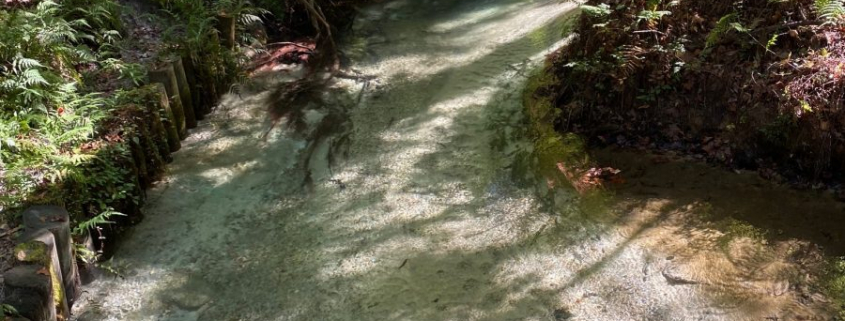Special Features at Auburn University’s Solon Dixon Forestry Center
The afternoon of October 15, 2022 and the following morning I visited the Solon Dixon Forestry Education Center with old friends Rhett Johnson, retired Center Director, and Emmett Thompson, Dean Emeritus, Auburn University College of Forestry, Wildlife, and Environment. Emmett’s son-in-lay Ken Pylant accompanied us. See my recent post highlighting the science and practice of managing longleaf pine at the Center: https://stevejonesgbh.com/2022/12/20/managing-longleaf-pine-at-auburn-universitys-solon-dixon-forestry-center/
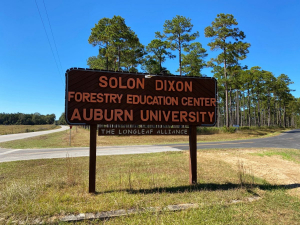
I feel a special thrill in the power and beauty of places that I hold dear, especially when enriched by fond memories. In fact, co-author Jennifer Wilhoit and I write of such sentiments in our book, Weaned Seals and Snowy Summits: Stories of Passion for Place and Everyday Nature. The Solon Dixon Center is one of those special places.
Spectacular Blue Spring
I focus this second Solon Dixon Post on special natural features we encountered on the Center. We hiked to Blue Spring, a special place that I elevated to spectacular! What lifted it to such a celestial level? I’ve always been a soft touch for isolated, dense woodland cover. Second, Blue Spring transported me several hundreds miles north into the Great Smokies. The comfortable deep shade, the sound of rushing water, and even the mix of tree species, in part, obliterated the truth that I stood just 30 miles or so north of the Gulf of Mexico. I admit to retaining an echo of northern forest ecosystem bias…a vestige of having spent my very early, formative forestry years much further north. After all, my subconscious reasoning concluded, “How could such a delightful place be in subtropical Alabama!?”
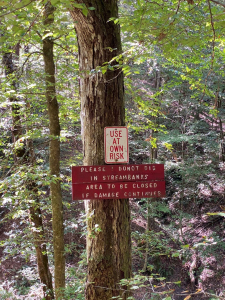
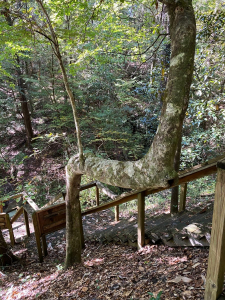
I’m self-medicating to jettison that unholy bias by repeated ventures into the forested wilds of Alabama…from Cheaha to Mobile! I ensure you that it’s working — I have become a shameless champion for Alabama’s magnificent forests and wildlands. However, I suppose that northern ecosystem bias is ever-present — resembling the ghost of alcoholism that haunts a former drunk (Am I allowed to phrase it in such a harsh manner?).
Blue Spring gushes some 13,000 gallons per minute of sparkling, pristine water, appearing from the rocks above this derelict foot bridge. The photo below could pass for white sand. Instead, the crystal water is flowing vigorously and transparently across the sandy stream bottom.
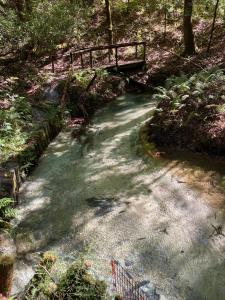
The vertical pilings at the left-side streambank hold bank erosion in check. Staff installed the measure to combat the destabilizing impacts of pedestrian wear along the stream to cross the now closed bridge. The sign below offers explanation.
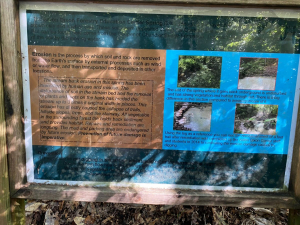
The same spot from above better depicts the volume of water, in this perspective appearing milky owing to the sandy bottom. The view below right shows the spring emerging just upstream of the bridge.
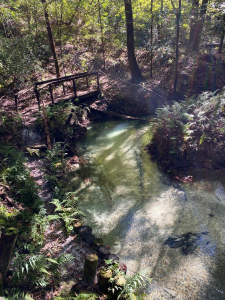
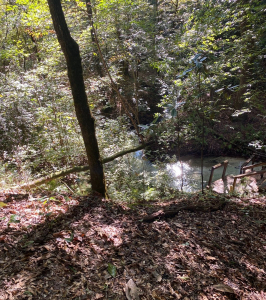
The stream drops once more into the limestone basement rock perhaps just 150 feet below the bridge. The spring’s fleeting surface passage adds an element of deep mystery and fantasy to the special nature of Blue Spring. I wonder how many forestry, wildlife, and environment students carry memories of the Center’s magic, spell-binding Blue Spring. This image hints at the Blue Spring moniker.
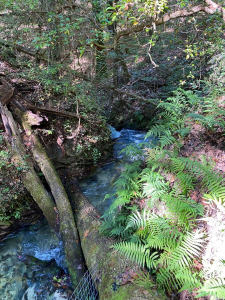
Rhett stands mid-way on the stairs ascending from the spring, perhaps reflecting on the countless young professional lives he touched during his 27 years as Solon Dixon Director. At right, he and Emmitt depart, leading the way to the interesting karst topography and forest awaiting our examination just a quarter of a mile downhill toward the Conecuh River. I lagged behind to capture another photo or two, then caught up to my colleagues.
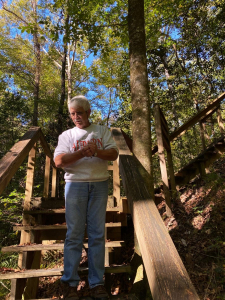
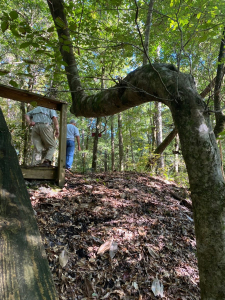
I recorded this 3:11 video at Blue Spring.
In keeping with my belief that a brief video tells a tale more powerfully than a few still photographs, I will endeavor to include at least one short video in all future Posts.
Nearby Karst Topography and Forest
Limestone underlays this section of the Center, the spring itself providing direct evidence of the karst topography. From the online Worldatlas.com:
Karst topography refers to a type of subterranean limestone caverns landscape, as well the mysterious-looking formations like caves, surface sinkholes, and rocky, overhanging cliffs, as a result of a specific natural occurrence.
We saw a few small sinks (not visible in this image) as we strolled toward the river.
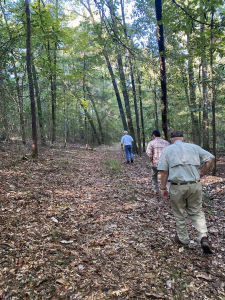
Shortly thereafter we entered an area with mysterious-looking formations like caves, surface sinkholes, and rocky, overhanging cliffs. The hole at left dropped 30 feet to the opening at right, rimmed in front by a limestone cliff.
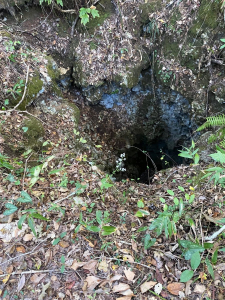
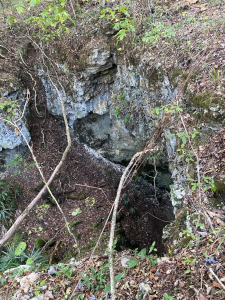
Two additional views of the distinct karst topography depict the sheltered opening and the forest assuring deep shade, hiding the rough landscape from aerial view. Although I could not capture the Conecuh River visible 50 feet below from the nearby high point, I imagined Native Americans fishing along the river, seeking overnight shelter in these overhangs and caves. I often observe that every place in Nature has a story to tell. Some speculate that Native Americans may have lived in these deep-South forests for 13,000 years. If so, how many traveling hunting/foraging parties may have sought refuge here over those 4.745 million nights?
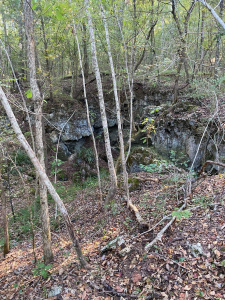
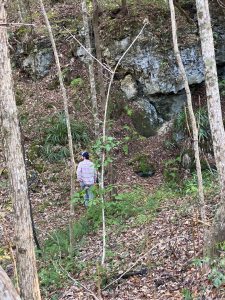
We think of the land and forest as unchanging, a static living ecosystem overlying the permanent land. Such is never the case. Over that geologically brief 13 millennia period, the forest has undergone many generations of change. Wildfire has occasionally ravaged even these hardwood stands. Hurricanes spinning ferociously from the nearby Gulf made landfall. Wild, tornadic thunderstorms have leveled the forest repeatedly. Yet, to the untrained, unknowing eye, this forest looks as though it perhaps witnessed the beginning of time.
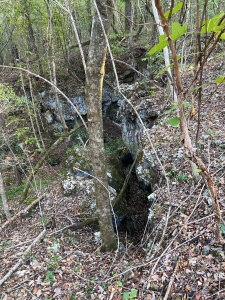
The basement limestone and its signature karst topography likely has changed, perhaps imperceptibly, over those 130 centuries yet, even so, slightly acidic rain and tannin-rich throughfall and litter-leached organic acids dissolve the limestone molecule by molecule. At the present rate of annual rainfall (60 inches), 65,000 feet of rain would have pounded this land over our 13,000 years. That’s 12.31 miles of rain!
Evergreen Ground Vegetation
Yucca beckoned my attention within the upland hardwood forest. Yes, I find it, albeit not common, in my northern Alabama home region. I saw it often during my several day wanderings in south Alabama, from Eufaula along the Chattahoochee to the Dixon Center.
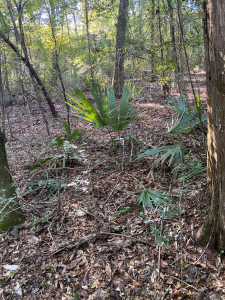
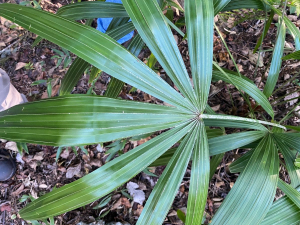
I don’t recall seeing needle palm in north Alabama. Tales of Native Americans crossing the forests barefoot are common. However, an errant bare foot encountering the spiny center of this plant would hobble even the toughest of warriors and foragers. A deer-hide moccasin would have been my preference.
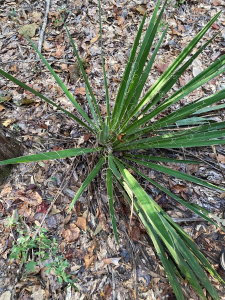
American holly, which extends abundantly into southern New England, ranges naturally throughout all of Alabama and across north Florida.
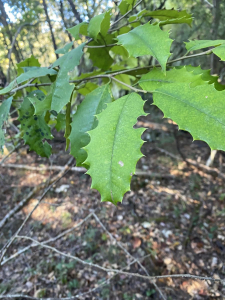
The dormant season hardwood forests of south Alabama can be rather drab. The evergreen ground and shrub species add an impression of vibrancy to the short winter season.
Feature Trees at this Special Place
Alabama hosts nine native pine species: loblolly; slash; white; pond; Virginia; shortleaf; longleaf; sand; and spruce. Spruce pine (pictured below) grows only in the southern half of Alabama. Its bark resembles black cherry, the primary tree species in the forests where I conducted my doctoral research. From online TreesForMe:
Spruce Pine, Pinus glabra (walter), found in the southeastern United States. An uncommon tree, it is usually found singly in mixed forests. This native evergreen conifer gets its name because of the way it produces smaller branches between the major branch whorls similar to a spruce. A medium sized tree, Spruce pines usually grow 80 to 100 feet tall and reach 2 to 2.5 feet in diameter. The single trunk is straight with horizontal, somewhat drooping branches supporting a spreading, irregular crown.
The native climate for Spruce pine has long, hot and humid summers followed by a short, mild winter. Rarely found in pure stands, It is more commonly found as a lone tree with other hardwood species in the coastal plains of the southeast. Pinus glabra prefers moist to wet sites in bottomland woods or along swamps and riverbanks.
I had not encountered spruce pine since leaving Union Camp in 1985. I felt like I was seeing an old friend after a 37 year absence. The bark is so unique among our Alabama pines that I recognized it immediately.
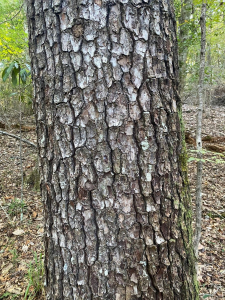
Eastern red cedar ranges over all of Alabama. I see red cedar wherever I roam. Because the species thrives best on limestone derived soils, I view it as a soil indicator species. This individual caught my eye. It is a single stem with multiple columns. I refer to it as an odd columnar red cedar, the likes of which I have not previously encountered. I can offer no explanation other than that the columnar tendency is genotypic. Were I in the ornamental nursery business, I might be inclined to vegetatively propagate a few specimens to test whether the trait repeats in other environments. I wonder whether the stem is as strong as it appears.
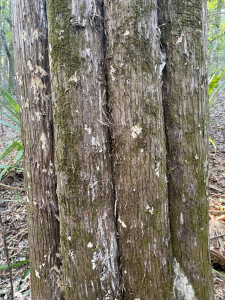
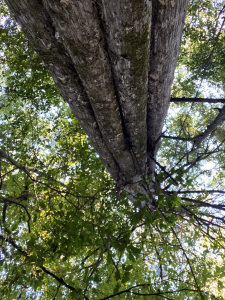
I shall remain forever vigilant for tree form curiosities and oddities!
Gopher Tortoise — A Keystone Species in the Longleaf Region
From a University of Florida online source:
Gopher Tortoises (Gopherus polyphemus) are one of five tortoise species native to North America and the only species found east of the Mississippi River. At one time the tortoise could be found as far north as North Carolina and as far West as Eastern Texas, but human activity and associated habitat loss, have shrunk their range considerably. Gopher Tortoises are considered a keystone species in that other animals depend on their burrows for survival. Tortoise burrows are used by over 350 other species, including the Burrowing Owl, and the endangered Eastern Indigo snake.
Gopher Tortoises are long lived, reaching up to 100 years of age in captivity and living 60 or more years in the wild. They weigh 8-15 pounds and measure 10-15 inches end to end when fully grown.
Named for the burrows they occupy, Gopher Tortoises excel at excavation, using their powerful legs to dig out tunnels that average 15 feet in length but can exceed lengths of 40 feet. These epic burrows offer protection from weather, fire, and predators and are where Gopher Tortoises spend most of their time. Gopher Tortoise burrows are easily identified by the single opening that is approximately the same width as the length of the tortoise, and by the sandy mound, or apron, that surrounds the entry.
We saw several gopher tortoise burrow openings with their distinctive soil apron. Ken provides scale at right.
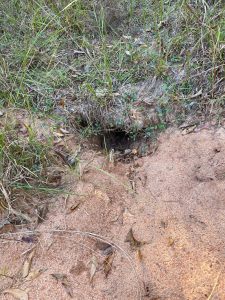
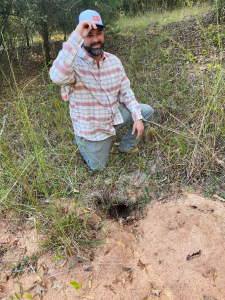
I find Nature’s beauty, magic, wonder, awe, and inspiration wherever I seek it. The Solon Dixon property proved the point. I enjoyed renewing old friendships and seeing the Center through the wizened eyes and deep, extended familiarity that Rhett possesses. I can only imagine what other treasures of Nature, science, and human interest that a longer visit could reveal.
Thoughts and Reflections
I offer these observations:
- A crystal spring in deep forest has special secrets to share.
- Karst topography accents the interaction of bedrock, climate, and forests.
- Trees can be like old friends, generating special feelings and refreshing deep memories.
Inhale and absorb Nature’s elixir. May Nature Inspire, Inform, and Reward you!
Note: All blog post images created & photographed by Stephen B. Jones unless otherwise noted. Please circulate images with photo credit: “©2023 Steve Jones, Great Blue Heron LLC. All Rights Reserved.”
Another Note: If you came to this post via a Facebook posting or by an another route, please sign up now (no cost… no obligation) to receive my Blog Post email alerts: http://eepurl.com/cKLJdL
And a Third: I am available for Nature-Inspired Speaking, Writing, and Consulting — contact me at steve.jones.0524@gmail.com
Reminder of my Personal and Professional Purpose, Passion, and Cause
If only more of us viewed our precious environment through the filters I employ. If only my mission and vision could be multiplied untold orders of magnitude:
Mission: Employ writing and speaking to educate, inspire, and enable readers and listeners to understand, appreciate, and enjoy Nature… and accept and practice Earth Stewardship.
Vision:
- People of all ages will pay greater attention to and engage more regularly with Nature… and will accept and practice informed and responsible Earth Stewardship.
- They will see their relationship to our natural world with new eyes… and will understand more clearly their Earth home.
Tagline/Motto: Steve (Great Blue Heron) encourages and seeks a better tomorrow through Nature-Inspired Living!
Steve’s Three Books
I wrote my books Nature Based Leadership (2016), Nature-Inspired Learning and Leading (2017), and Weaned Seals and Snowy Summits: Stories of Passion for Place and Everyday Nature (2019; co-authored with Dr. Jennifer Wilhoit) to encourage all citizens to recognize and appreciate that every lesson for living, learning, serving, and leading is either written indelibly in or is powerfully inspired by Nature.
I began writing books and Posts for several reasons:
- I love hiking and exploring in Nature
- I see images I want to (and do) capture with my trusty iPhone camera
- I enjoy explaining those images — an educator at heart
- I don’t play golf!
- I actually do love writing — it’s the hobby I never needed when my career consumed me
- Judy suggested my writing is in large measure my legacy to our two kids, our five grand kids, and all the unborn generations beyond
- And finally, perhaps my books and Blogs could reach beyond family and touch a few other lives… sow some seeds for the future

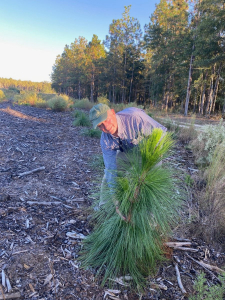
All three of my books (Nature Based Leadership; Nature-Inspired Learning and Leading; Weaned Seals and Snowy Summits) present compilations of personal experiences expressing my (and co-author Dr. Wilhoit for Weaned Seals and Snowy Summits) deep passion for Nature. All three books offer observations and reflections on my relationship to the natural world… and the broader implications for society. Order any and all from your local indie bookstore, or find them on IndieBound or other online sources such as Amazon and LifeRich.

